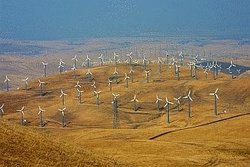Wind turbine technology has made great gains over the years and simply swapping out older turbines with new ones greatly increases the energy those wind farms produce.
GlobalData expects repowering to grow dramatically over the coming five years, increasing annual power generation at these sites from 1524 gigawatt hours (GWh) to 8221 GWh by 2020.
Today’s wind turbines generate much more electricity than those built in the 1970s-1990s and are also much quieter and more reliable.
The world’s oldest wind farm – Altamont Pass in California – is in the midst of repowering. First developed in the 1970s, on 50,000 acres leased from cattle ranchers, it looks quite different today. Easily visible from the road, Altamont has been many peoples’ first view of a wind farm.
The original wind farm:

2400 of the original 4000 turbines are being replaced by just 100, 2.3 MW turbines, each 430-feet tall, higher than a redwood. The rest are being shut down.
"The old ones would shut down if the winds got too strong, and then they’d fall down and hit the wires and start grass fires. These spin slower than the old ones, and they are very quiet," says John Jackson, a local cattle rancher. They were also killing about 4300 birds a year, a third of which were protected raptors such as golden eagles. The Altamont Pass lies on a major migratory route and is an important breeding area. The new turbines are being sited in less environmentally sensitive areas.
"15 years ago many countries had just started installing wind turbines but Germany, Denmark, the U.S. and the Netherlands already had a decent amount of wind capacity," says Prasad Tanikella of GlobalData. These wind energy pioneers are now at the forefront of the repowering movement. And, as their onshore fleets age, Spain, Italy, Portugal, India and the UK are becoming repowering hot spots too.
Some countries provide the same subsidies for repowering as for new installations, and Germany gives a bonus. Not surprisingly, much of the world’s repowering is happening there, where land and good wind sites are at a premium.
Denmark is the other country that leads on repowering because it has lots of old wind farms and generous subsidies.
Denmark’s biggest onshore repowering project will replace 395, 17-year-old Vestas turbines rated at 600 kW, with 22, 3 MW turbines, says Renewable Energy World. GlobalData expects Denmark to replace 200 MW of old turbines with 1 GW of repowered capacity a year by 2020.
The US comes third on repowering rankings, especially in California, where 1500 turbines have been repowered, according to the American Wind Energy Association (AWEA).
And there’s a world market for well-maintained old turbines in places like Vietnam, South America, Romania, Bulgaria, Poland, and Turkey, says Renewable Energy World.
Read the full story at Renewable Energy World:

